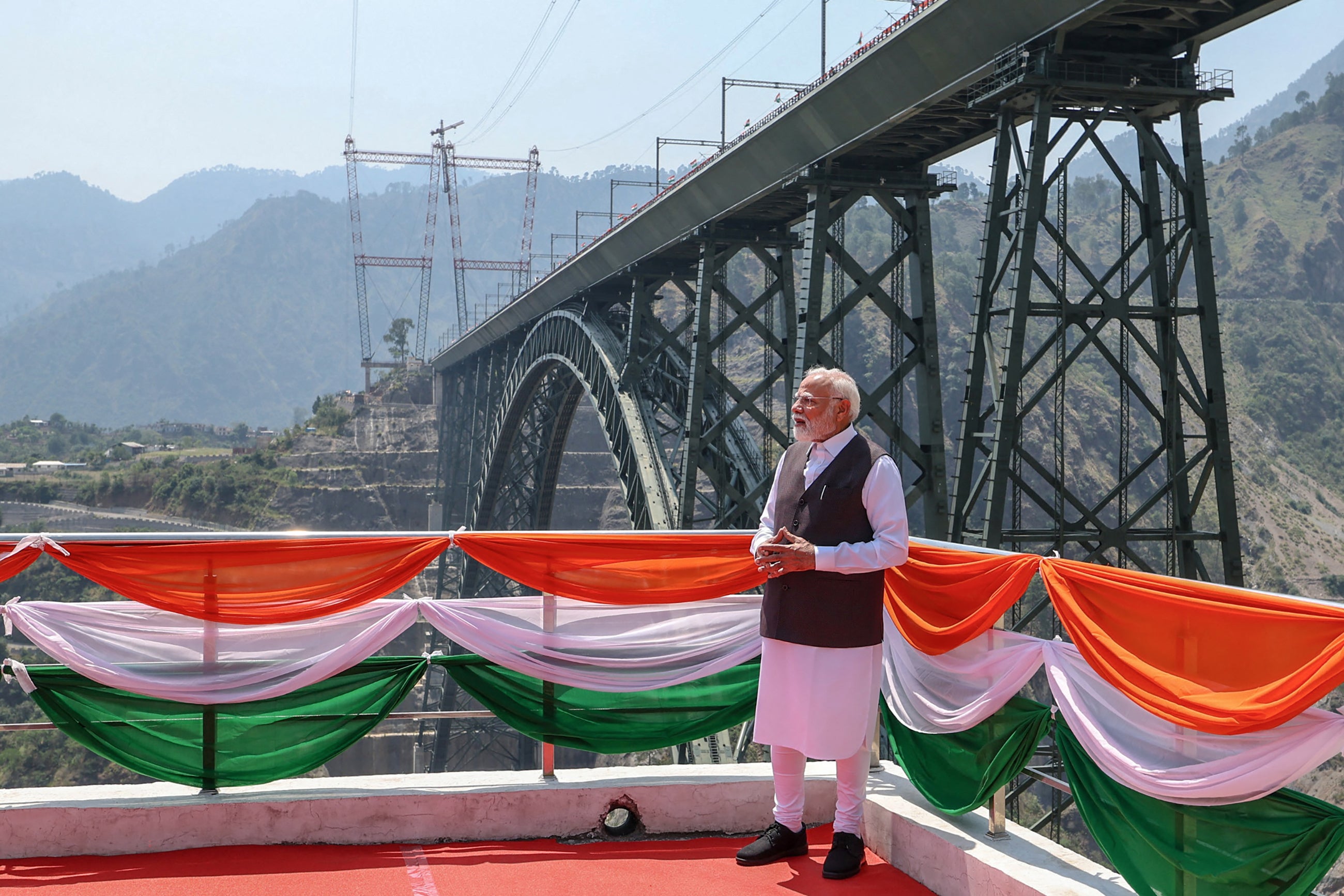Indian prime minister Narendra Modi on Friday inaugurated the Chenab Railway Bridge – the tallest railway arch bridge in the world which is 35m taller than the Eiffel Tower.
Towering at 359m above the Chenab river in the Reasi district of the federal territory of Jammu and Kashmir, the bridge is a key part of the Udhampur-Srinagar-Baramulla Rail Link (USBRL) project and connects the Kashmir region with the rest of the country via an all-weather rail line.
Spanning 1,315m between the villages of Bakkal and Kauri, the bridge was constructed using over 28,000 tonnes of steel and designed to last 120 years. It features 93 deck segments, each weighing around 85 tonnes, and can withstand wind speeds of up to 266kmph and seismic tremors up to magnitude 8, according to the Indian Express.
After the inauguration, Mr Modi posted on X, formerly Twitter: “It’s a feeling of immense pride that this bridge seamlessly blends ambition with execution, reflecting India’s growing capability to build futuristic infrastructure in the most challenging terrains.”
The Tricolour flies high over the Chenab Rail Bridge!
— Narendra Modi (@narendramodi) June 6, 2025
It’s a feeling of immense pride that this bridge seamlessly blends ambition with execution, reflecting India’s growing capability to build futuristic infrastructure in the most challenging terrains. pic.twitter.com/PrqELwfO7k
One of the primary engineering challenges was stabilising the slopes in a region marked by fractured Himalayan geology and high seismic activity. The bridge’s structural resilience includes the capacity to remain operational even if one of its piers fails, at a restricted speed of 30kmph. It is also designed to withstand explosive forces up to 40 tonnes of TNT.
G Madhavi Latha, a specialist in rock engineering at the Indian Institute of Science (IISc), was brought in by Northern Railways and Afcons Infrastructure to advise on slope stabilisation and foundation design. “We couldn’t go with a rigid design. The data we found during excavation was very different from what surface mapping had indicated,” Ms Latha told Deccan Herald.

Describing the process of designing the bridge, Ms Latha explained that the team needed to often modify construction plans in real-time based on new geological data. Cement grouting, reinforcement with steel rods, and deep excavations into rock mass were used to stabilise the foundations; Ms Latha added that several adjustments had to be incorporated due to the steep, unstable slopes and highly discontinuous rock formations.
Additionally, with no pre-existing roads to the remote site, transporting heavy machinery posed a major hurdle. Workers had to build over 26km of motorable roads before main construction could even begin. This isolation, combined with weather extremes and logistical constraints, hindered the bridge’s construction progress multiple times.
A historic moment as the first Vande Bharat Train crosses the world’s highest railway bridge over the Chenab River in Jammu & Kashmir.
— Ravneet Singh Bittu (@RavneetBittu) June 5, 2025
While it took over seven decades to connect J&K by rail, the vision and resolve of the Modi Government made it a reality in just four years after… pic.twitter.com/90PTCB3OX1
The USBRL project as a whole has been under development since it was approved in 2003 during former prime minister Atal Bihari Vajpayee’s administration. It includes 36 tunnels spanning 119 kilometres and 943 bridges, built at a total estimated cost of Rs437.8bn (£3.7bn), with the cost of the Chenab Bridge alone being approximately Rs14.86bn (£128m), reported Indian media.
The Chenab Bridge was constructed under the supervision of the Konkan Railway Corporation and involved several Indian and international partners. The viaduct and foundation were designed by WSP Finland, while the steel arch was designed by Germany-based Leonhardt Andrä und Partner. Construction was carried out by a joint venture comprising Afcons Infrastructure (India), South Korea’s Ultra Construction & Engineering, and VSL India. Seismic analysis was conducted by IIT Delhi and IIT Roorkee, while the Defence Research and Development Organisation (DRDO) contributed to making the bridge blast-resistant.
The bridge lies on a transition curve – a section where a straight alignment shifts to a curved one – adding complexity to its design and construction. Sophisticated Tekla software was used for 3D modelling of the structure, Swiss firm Mageba supplied spherical bearings, while the Steel Authority of India provided the raw materials for the arch.
Jammu & Kashmir chief minister Omar Abdullah visited the bridge a day before the inauguration to review arrangements and shared pictures on X, writing: “ Tomorrow is a landmark day for J&K when, finally, the valley will be connected to the rest of the country by a railway link to be inaugurated at the hands of the Hon PM.”
Visited the tallest railway bridge in the world, The Chenab Bridge, to review arrangements for the visit of the Hon PM @narendramodi ji tomorrow. Tomorrow is a landmark day for J&K when, finally, the valley will be connected to the rest of the country by a railway link to be… pic.twitter.com/bthZVHQ33j
— Omar Abdullah (@OmarAbdullah) June 5, 2025
At its peak in 2017, the Chenab Bridge project employed around 3,200 workers and engineers working simultaneously, according to a report in The New Indian Express. To support this large workforce in the remote and difficult terrain, a dedicated residential colony with 52 housing blocks was established close to the site, ensuring uninterrupted progress despite the challenging conditions.
Now fully operational, the bridge is intended to serve as a vital link for both civilian and strategic transport. The rail route connecting Katra in Jammu to Srinagar in Kashmir is expected to significantly cut travel time down to three hours via the Vande Bharat Express, compared to the previous five to six hours.
Two children among 11 killed in stampede during IPL title parade
India-Pakistan violence casts dark shadow over Kashmir pilgrimage
Elon Musk’s Tesla ‘not interested’ in manufacturing in India, minister says
Indian lawmaker slammed for blaming women who lost husbands in Kashmir attack
Top cricket official among four arrested over deadly stadium crush in India
Eleven die in Bengaluru stampede during IPL title celebrations







